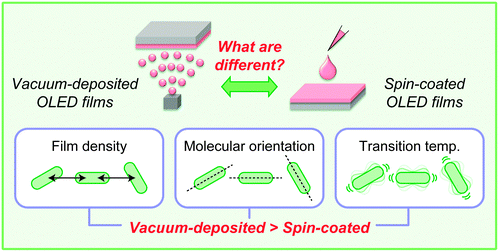Advantages and disadvantages of vacuum-deposited and spin-coated amorphous organic semiconductor films for organic light-emitting diodes†
Abstract
To realize low-cost fabrication processes for high-performance organic light-emitting diode (OLED) display and lighting, it has recently become important to understand the properties and structures of solution-processed amorphous films. In particular, to choose an appropriate process to produce OLEDs to meet the demands of a realistic situation, it is necessary to know the general advantages and disadvantages of vacuum- and solution-processed films quantitatively. However, the differences between the films formed by these processes are not yet sufficiently clear. Here we systematically compare vacuum-deposited and spin-coated amorphous organic semiconductor films used for OLEDs mainly by ellipsometry, and demonstrate the critical differences in film density, transition temperature, and molecular orientation. We found that the film density, transition temperature, and degree of horizontal molecular orientation of small-molecule spin-coated films are inherently lower than those of the corresponding vacuum-deposited ones. In addition, we show that the transition temperature and molecular orientation of small-molecule spin-coated films of glassy materials are identical to those of “deteriorated” vacuum-deposited films that have experienced a transition induced by heating. Our comprehensive comparisons lead to guidelines for selecting suitable processes and materials for production and clarify the future challenges to be addressed to facilitate the development of high-performance solution-processed OLEDs.


 Please wait while we load your content...
Please wait while we load your content...